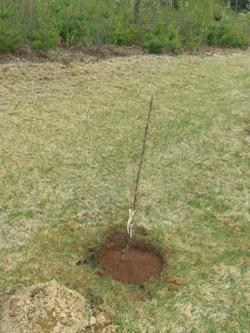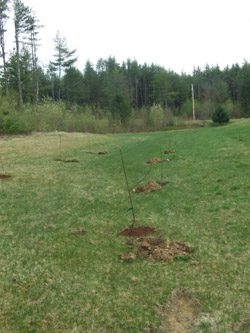How To Plant Apple Trees
Planting Apple Trees
 Spring time is a great time to plant fruit trees like apples, peaches and pears. This year we’re planting apple and peach trees in our yard as we continue to improve upon our yards landscape. In this article I’d like to share some tips on how to plant apple trees. Planting fruit trees is an easy DIY home improvement project for families to enjoy.
Spring time is a great time to plant fruit trees like apples, peaches and pears. This year we’re planting apple and peach trees in our yard as we continue to improve upon our yards landscape. In this article I’d like to share some tips on how to plant apple trees. Planting fruit trees is an easy DIY home improvement project for families to enjoy.
Tree Placement
Before planting the apple trees it’s important to select a location that receives full sunlight throughout the day. It’s also important that you plant trees that require cross-pollination close enough to each other as required by the tree type (read more about it in the previous article about planting apple and peach trees).
Tree spacing depends on the type of root stock and therefore size of the mature tree. Our trees are EMLA 7 rootstock which means they will mature to a height of 12′ to 15′. Spacing should be roughly the same as the mature height. Therefore we planted our trees 15 feet apart.
Digging Holes
We purchased apple trees that have a trunk diameter of approximately 1/2 inch with a total height of about 3′ to 4′. According to Adams County Nursery (where we purchased our trees) the holes should be approximately 18 inches in diameter and 18 inches deep. It’s really important that you break up any hardpan layers or stiff clays to improve water drainage.
Planting Apple Trees
 Once the holes are prepared it’s time to plant the actual apple tree. It’s very important that you NOT place raw fertilizer in the hole as it will damage the roots. Before placing the tree in the hole I like to water the hole well.
Once the holes are prepared it’s time to plant the actual apple tree. It’s very important that you NOT place raw fertilizer in the hole as it will damage the roots. Before placing the tree in the hole I like to water the hole well.
The tree should be placed into the hole so that the final backfill is located approximately 2 inches below the bud union. Use a good quality top soil and be sure it’s compacted around the roots so there are no voids.
Watering and Fertilizers
New trees must be watered on a regular basis. If nature doesn’t provide watering from rain then you should plan on watering the trees at least once a week for the entire growing season. The literature recommends 3 to 4 gallons for each tree.
New trees can be fertilized about one month after they are planted. ACN recommends 4 oz. of 10-10-10 fertilizer per tree around the base of the tree, being careful not to get it too close to the trunk.
Pruning
Transplanted trees must be pruned in order to promote good root growth before the tree expends energy on branches and leafs. Scaffold branches below 18 inches should be removed. The leader should be cut down to 18 inches above the top most scaffold branch. Finally all the scaffold branches should be cut back to a length of 12 inches.















Leave a comment